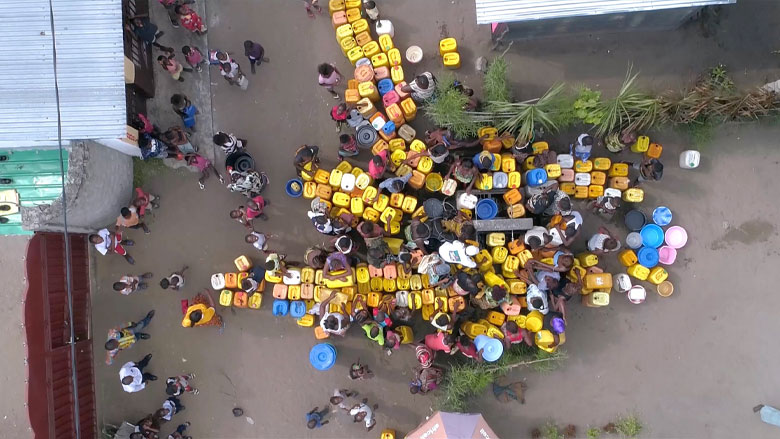Access to Drinking Water in Kinshasa, DRC: A Path Towards Sustainable Development

“Drinking water is a rare commodity here. We struggle with boreholes (a deep, narrow hole for water extraction), and sometimes the boreholes in question break down, and we go a bit further,” explains JR Mauwa who hopes to gain a consistent supply of water and be a beneficiary of the project.
The Challenge of Water Scarcity in Kinshasa
This sheds a light on the daily challenges faced by the residents of Kinshasa in the Democratic Republic of Congo (DRC). Such lack of water naturally creates a hygiene problem that has a significant impact on the living conditions in the city. The lack of water is also a real physical constraint. The time spent fetching and transporting water is considerable, depriving the people of Kinshasa of another essential resource: time. This time cannot be devoted to work, domestic chores, or training, and it disproportionately affects women. According to UNICEF, women and girls spend 200 million hours collecting water every year, taking away valuable time that they could spend on education and work, directly affecting the building of the country’s human capital.
The Importance of Access to Safe Drinking Water
Water is a vital resource, so crucial that we often take it for granted when it’s readily available. However, when it is lacking, every daily action becomes more difficult for those who are deprived of it. Water is an indispensable resource for quenching our thirst, maintaining personal hygiene, cooking, and preserving good health. Regrettably, at a global level, having access to safe drinking water is a privilege, not a reality for everyone.
While access to water is progressing in many parts of the world, the situation in Sub-Saharan Africa (SSA) is deteriorating, with an increasing number of people deprived of access. Among the countries affected by this reality, the DRC stands out sadly, with one of the lowest rates of access to drinking water and adequate sanitation in SSA. According to UNICEF, only 52% of the population has access to an improved water source and 29% to improved sanitation facilities. The paradox lies in the country’s abundance of water resources: the DRC possesses more than 50% of the African continent’s water reserves. Despite this natural wealth, drinking water remains a rare commodity for the Congolese population, mainly due to the lack of infrastructure.
The Kin Elenda Project: Enhancing Access to Drinking Water
Kinshasa’s Multisectoral Development and Urban Resilience Project, named Kin Elenda, is funded by the International Development Association (IDA), part of the World Bank that helps the world’s poorest countries. The $500 million project started in 2021, aiming to strengthen urban management and improve basic urban services, such as water, sanitation, waste management and energy, through climate change-resistant infrastructure.
The primary investments of the project encompass the construction of the Binza Ozone water treatment complex, the revitalization of the current Ndjili water treatment plant, and the upgrade and expansion of the water storage and distribution network.
The first phase of the Binza Ozone water treatment complex, designed to handle 110,000 m3/d, was inaugurated on February 23, 2020, at an approximate cost of $60 million. Since its inauguration, it has significantly enhanced services for nearly a million people, including neighborhoods that lacked access to water for over a decade. The project is presently expanding the distribution network downstream of the ozone plant. Once the construction on the Binza Ozone treatment complex is finalized (expected completion by June 2026), this extension will extend services to more than 2 million individuals.
The Significance of Kin Elenda Project for Sustainable Development
The Kin Elenda Project will be even more crucial in the metropolis of Kinshasa, which is home to a population of over 14 million people, with an annual growth rate of 5.1%, and could become Africa’s most populous city by 2030. This rapid urban growth poses two major challenges. On the one hand, there is the challenge of making cities more livable and inclusive by meeting the high demand for social services, infrastructure, education, healthcare, and other basic services, while at the same time tackling significant urban poverty. On the other hand, it is essential to make cities more productive by encouraging a greater concentration of economic activity. In this fast-growing megalopolis, for example, the drinking water supply infrastructure is struggling to keep pace. As a result, many people have difficulty gaining continuous access to drinking water.
“I can just turn on the tap and drink the water now, no need for boiling anymore. Gideon, how about a glass of water? It’s perfectly safe to drink. Thanks to God, we’re blessed with this,” proudly states a resident of Kinshasa , who benefited from the World Bank-supported Kinshasa Multisectoral Development and Urban Resilience Project.
“The water now flows into our bathrooms with high pressure, and we’re thrilled about it. I can draw water directly from the tap and drink it, whereas previously I had to boil it. ‘Gédéon, would you like a glass of water?’ remarked another resident. ‘This water is drinkable. We give thanks to God.”
Conclusion: Investing in Access to Drinking Water for Sustainable Development
SDGs, Targets, and Indicators
| SDGs | Targets | Indicators |
|---|---|---|
| SDG 6: Clean Water and Sanitation | 6.1 By 2030, achieve universal and equitable access to safe and affordable drinking water for all | Percentage of population with access to improved water source |
| SDG 6: Clean Water and Sanitation | 6.2 By 2030, achieve access to adequate and equitable sanitation and hygiene for all and end open defecation, paying special attention to the needs of women and girls and those in vulnerable situations | Percentage of population with access to improved sanitation facilities |
| SDG 5: Gender Equality | 5.4 Recognize and value unpaid care and domestic work through the provision of public services, infrastructure, and social protection policies and the promotion of shared responsibility within the household and the family as nationally appropriate | Time spent by women and girls collecting water |
| SDG 11: Sustainable Cities and Communities | 11.1 By 2030, ensure access for all to adequate, safe, and affordable housing and basic services and upgrade slums | Improvement in urban management and basic urban services, such as water, sanitation, waste management, and energy |
| SDG 11: Sustainable Cities and Communities | 11.3 By 2030, enhance inclusive and sustainable urbanization and capacity for participatory, integrated, and sustainable human settlement planning and management in all countries | Population growth rate in urban areas |
1. Which SDGs are addressed or connected to the issues highlighted in the article?
SDG 6: Clean Water and Sanitation
The article discusses the lack of access to safe drinking water in Kinshasa, highlighting the challenges faced by the residents. This directly connects to SDG 6, which aims to ensure availability and sustainable management of water and sanitation for all.
SDG 5: Gender Equality
The article mentions that the lack of access to water disproportionately affects women and girls, as they spend a significant amount of time collecting water. This relates to SDG 5, which focuses on achieving gender equality and empowering all women and girls.
SDG 11: Sustainable Cities and Communities
The article emphasizes the rapid urban growth in Kinshasa and the challenges it poses in providing basic services like drinking water. This aligns with SDG 11, which aims to make cities inclusive, safe, resilient, and sustainable.
2. What specific targets under those SDGs can be identified based on the article’s content?
Under SDG 6: Clean Water and Sanitation:
– Target 6.1: By 2030, achieve universal and equitable access to safe and affordable drinking water for all.
– Target 6.2: By 2030, achieve access to adequate and equitable sanitation and hygiene for all and end open defecation, paying special attention to the needs of women and girls and those in vulnerable situations.
Under SDG 5: Gender Equality:
– Target 5.4: Recognize and value unpaid care and domestic work through the provision of public services, infrastructure, and social protection policies and the promotion of shared responsibility within the household and the family as nationally appropriate.
Under SDG 11: Sustainable Cities and Communities:
– Target 11.1: By 2030, ensure access for all to adequate, safe, and affordable housing and basic services and upgrade slums.
– Target 11.3: By 2030, enhance inclusive and sustainable urbanization and capacity for participatory, integrated, and sustainable human settlement planning and management in all countries.
3. Are there any indicators mentioned or implied in the article that can be used to measure progress towards the identified targets?
The article mentions or implies the following indicators:
– Percentage of population with access to improved water source: This indicator can measure progress towards SDG 6.1, which aims to achieve universal access to safe drinking water. The article states that only 52% of the population in the DRC has access to an improved water source.
– Percentage of population with access to improved sanitation facilities: This indicator can measure progress towards SDG 6.2, which focuses on achieving equitable access to sanitation. The article mentions that only 29% of the population in the DRC has access to improved sanitation facilities.
– Time spent by women and girls collecting water: This indicator can measure progress towards SDG 5.4, which aims to recognize and value unpaid care work. The article highlights that women and girls spend a significant amount of time collecting water, depriving them of time for education and work.
– Population growth rate in urban areas: This indicator can measure progress towards SDG 11.3, which aims to enhance sustainable urbanization. The article mentions that Kinshasa has an annual growth rate of 5.1%, highlighting the rapid urban growth in the city.
4. Table: SDGs, Targets, and Indicators
| SDGs | Targets | Indicators |
|---|---|---|
| SDG 6: Clean Water and Sanitation | 6.1 By 2030, achieve universal and equitable access to safe and affordable drinking water for all | Percentage of population with access to improved water source |
| SDG 6: Clean Water and Sanitation | 6.2 By 2030, achieve access to adequate and equitable sanitation and hygiene for all and end open defecation, paying special attention to the needs of women and girls and those in vulnerable situations | Percentage of population with access to improved sanitation facilities |
| SDG 5: Gender Equality | 5.4 Recognize and value unpaid care and domestic work through the provision of public services, infrastructure, and social protection policies and the promotion of shared responsibility within the household and the family as nationally appropriate | Time spent by women and girls collecting water |
| SDG 11: Sustainable Cities and Communities |







